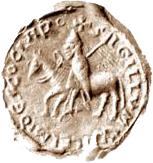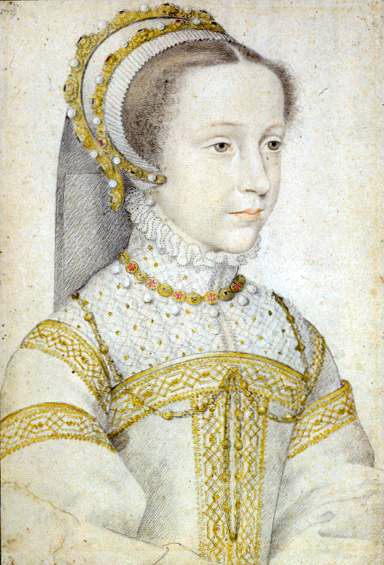Janet Sinclair, ‘darling nurse’ of Mary Queen of Scots
Unfortunately we have no conclusive evidence as to the family of Janet Sinclair, the ‘darling nurse’ of Mary Queen of Scots, however, she must have been well connected to one of the noble lines of Sinclair to have been employed as a royal nurse in the first place and, in any event, she certainly had an interesting life at the courts of Scotland and France. Janet, or ‘Jain’ as she called herself, was married to John Kemp, ‘tronar’ of Haddington; a ‘tronar’ was in charge of the ‘tron’, a weighing instrument used for weighing wool bound for export, with officially stamped and accurate weights, known as ‘tron stones’, used to calculate the customs duties payable. John would have been paid one penny per sack of wool weighed. In 1515, a William Kemp was appointed as tronar of Haddington and this job may have been an hereditary position passed from father to son.
John Kemp was also employed in the royal household; between 1529 and 1536 he is noted as paid for his service ‘in the petty larder’ or in charge of controlling the food supplies in each of the various royal households. Between 1534 and 1539 a John Kemp was paid as a ‘trumpeter/trumpeter of war’, presumably the same man, with some musical talent. There were several other Kemps employed in royal service at the same time who may be related to John; an Alexander Kemp was a ‘groom of the chamber’ between 1526 and 1542, and Henry Kemp of Thomastoun in Fife was a favourite of King James V, performing duties as ‘cupbearer’ alongside Oliver Sinclair of Pitcairn. In February 1540 Henry Kemp of Thomastoun sold the lands of Hartside in Haddington to George Home of Spott and Katherine Halkerston, which seem to be lands he held prior to any rewards for his service as gifts from King James V. They seem to indicate a Haddington origin for him, but again there is no hard evidence any of these Kemps were related.
Given these tentative Haddington connections through her husband, Janet may have been from the St Clair of Herdmanston family or one of its branches. She had been in royal service employed as a nurse since just before the birth of Prince James (May 1540–April 1541), when the Treasury accounts mention that King James V had authorised a payment to her of £40 ‘for her service and reward.’ Janet was called back into royal service in 1542 by the Queen, Mary of Guise, once again as nurse to the new royal baby, who would shortly become Mary, Queen of Scots. On 12 March 1542–3, Janet and her husband were gifted a life-rent of the lands of Newtonlees in the lordship of Dunbar, Berwickshire, by the Queen, for Janet’s ‘good service’. On 20 November 1544, Janet and her husband were rewarded once again by the Queen Dowager with a life-rent of the mails, profits and duties of the town and lands of Corntoun, with its meadows and fishings in Logie parish, Stirlingshire, for ‘the service of said Janet as our nurse.’
Janet’s young charge was crowned Queen of Scots on 20 December 1542, six days after her father’s death. There soon followed years of pressure from the English who were trying to negotiate a marriage contract between young Mary and Prince Edward, the son of King Henry VIII. Most objectionably, the English insisted Mary should be brought up in the English court for all of her childhood until the marriage. The Scots were not keen on that idea and, moreover, the catholic Scottish faction preferred an alliance with the French, leading to English retaliation commonly known as ‘the rough wooing’.
A few years later, after several skirmishes, the Scots were overwhelmingly defeated by the English at Pinkie Cleugh on 10 September 1547. Janet Sinclair, the four Marys (Fleming, Beaton, Livingstone and Seaton), the Queen-Dowager Mary of Guise, the governess, Lady Fleming and the young Queen’s guardians – the Lords Livingstone and Erskine – hurriedly accompanied the almost-five-year-old Queen into hiding at Inchmahome Priory, on an island in the Lake of Menteith in Stirlingshire. The following August, the young Queen and her thirty-strong household were smuggled out of Scotland by ship from Dumbarton and on arrival at Brest in France, her household was installed at the French royal nursery at St Germain-en-Laye. Janet Sinclair and John Kemp formed part of the young Queen’s household, along with their own son and daughter.
In early 1549, allegedly on the interference of Catherine de Medici, the Queen Consort of France, Queen Mary’s little household was removed to Blois in the Loire Valley. During that upheaval some of the Scottish servants were dismissed and replaced by French servants, creating much antagonism between the Scottish and French households. An indignant Janet Sinclair wrote a letter of complaint, firstly to Antoinette de Bourbon, Queen Mary’s grandmother, which did not produce the desired effect. Secondly, she wrote to Queen Mary’s mother, Mary of Guise, back in Scotland, describing her life at the French court, of her irregularly paid low wages and how she had been deprived of her authority in the nursery, along with her allowance of candles, wine and fire. Also, her husband had not received his wages and worst of all, she was forced to take her dinner and supper with two Frenchwomen of whom she did not approve and felt were beneath her station as a gentlewoman. Mary of Guise intervened with the King of France and insisted that Lady Fleming remain as her daughter’s governess and that Janet Sinclair should remain her nurse. Lady Fleming however, became pregnant by the King of France, Henry II, and gave birth to a son in April 1551. Catherine de Medici ensured Lady Fleming was sent home in disgrace with her newborn baby.
John Kemp was employed as the young Queen’s master of the wardrobe, who referred to him as her ‘foster father’ and in one of her letters to her mother, she said of him: ‘he takes more and more pains in my service.’ As John and Janet’s son, also named John, grew old enough, the young Queen wrote to her mother asking that a position in the church might be found for him, as a favour to her faithful servants. She frequently wrote to her mother urging her to raise the wages of John Kemp. Within a few years, however, they both appear to have left Queen Mary’s service prior to her marriage to the Dauphin of France in 1558.
Janet died around 1557, when she is first referred to as ‘quondam Janet Sinclair, nutrice domine notre regine’ in the treasury accounts for Corntoun. John Kemp was a witness for James Stirling of Keir at Stirling in 1556, so they had returned to Scotland before then. John survived Janet for at least another decade; in 1566 he is noted as a burgess of Edinburgh in an obligation by Sir William Murray of Tullibardine, the Comptroller of Scotland, to John and two other burgesses. On 6 October 1565, John confirmed he had received a payment of 1200 merks from Patrick Hepburn of Wauchton, who had borrowed that sum from John sometime previously, with Patrick securing the loan on his lands of Lufness, East Lothian. In the interim, John collected the annual rents of 108 merks until, in October 1565, Patrick repaid the loan and John renounced all claim to Lufness. Interestingly, the witnesses to this notarial instrument include John Sinclare, baker, burgess of Edinburgh and Henry Sinclare, son of Thomas Sinclare, writer of the Privy Seal of the King and Queen [and procurator for Patrick Hepburn]. It is tantalisingly suggestive that these Sinclairs were related to Janet somehow and they had an interest in John Kemp’s business either on their relative’s behalf, or that of their children.
Also interestingly, in 1536, Patrick Hepburn of Wauchton and his accomplices had been convicted of an assault against James, brother of William Sinclair of Roslin, and Patrick’s lands were forfeited to the Crown as punishment. However, he had his lands returned to him just four months later, having secured a remission for his crime on payment of 1000 merks, which must have irritated the Roslin Sinclairs. All in all, a profusion of Sinclair connections but still no way of knowing for certain which branch of the family tree ‘darling nurse’ Janet was from!
Nina Cawthorne

